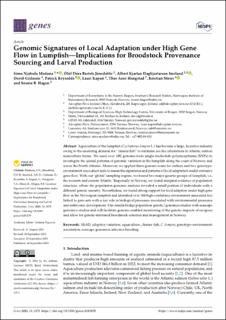| dc.contributor.author | Maduna, Simo | |
| dc.contributor.author | Jónsdóttir, Ólöf Dóra Bartels | |
| dc.contributor.author | Imsland, Albert | |
| dc.contributor.author | Gíslason, Davíð | |
| dc.contributor.author | Reynolds, Patrick | |
| dc.contributor.author | Kapari, Lauri Teemu | |
| dc.contributor.author | Hangstad, Thor Arne | |
| dc.contributor.author | Meier, Kristian | |
| dc.contributor.author | Hagen, Snorre | |
| dc.date.accessioned | 2023-10-04T13:18:33Z | |
| dc.date.available | 2023-10-04T13:18:33Z | |
| dc.date.created | 2023-09-27T15:19:18Z | |
| dc.date.issued | 2023-09-26 | |
| dc.identifier.citation | Maduna, S. N., Jónsdóttir, Ó. D. B., Imsland, A. K. D., Gíslason, D., Reynolds, P., Kapari, L., Hangstad, T. A., et al. (2023). Genomic Signatures of Local Adaptation under High Gene Flow in Lumpfish—Implications for Broodstock Provenance Sourcing and Larval Production. Genes, 14(10), 1870. MDPI AG | en_US |
| dc.identifier.issn | 2073-4425 | |
| dc.identifier.uri | https://hdl.handle.net/11250/3094185 | |
| dc.description.abstract | Aquaculture of the lumpfish (Cyclopterus lumpus L.) has become a large, lucrative industry owing to the escalating demand for “cleaner fish” to minimise sea lice infestations in Atlantic salmon mariculture farms. We used over 10K genome-wide single nucleotide polymorphisms (SNPs) to investigate the spatial patterns of genomic variation in the lumpfish along the coast of Norway and across the North Atlantic. Moreover, we applied three genome scans for outliers and two genotype–environment association tests to assess the signatures and patterns of local adaptation under extensive gene flow. With our ‘global’ sampling regime, we found two major genetic groups of lumpfish, i.e., the western and eastern Atlantic. Regionally in Norway, we found marginal evidence of population structure, where the population genomic analysis revealed a small portion of individuals with a different genetic ancestry. Nevertheless, we found strong support for local adaption under high gene flow in the Norwegian lumpfish and identified over 380 high-confidence environment-associated loci linked to gene sets with a key role in biological processes associated with environmental pressures and embryonic development. Our results bridge population genetic/genomics studies with seascape genomics studies and will facilitate genome-enabled monitoring of the genetic impacts of escapees and allow for genetic-informed broodstock selection and management in Norway. | en_US |
| dc.language.iso | eng | en_US |
| dc.publisher | MDPI | en_US |
| dc.rights | Navngivelse 4.0 Internasjonal | * |
| dc.rights.uri | http://creativecommons.org/licenses/by/4.0/deed.no | * |
| dc.title | Genomic Signatures of Local Adaptation under High Gene Flow in Lumpfish—Implications for Broodstock Provenance Sourcing and Larval Production | en_US |
| dc.title.alternative | Genomic Signatures of Local Adaptation under High Gene Flow in Lumpfish—Implications for Broodstock Provenance Sourcing and Larval Production | en_US |
| dc.type | Peer reviewed | en_US |
| dc.type | Journal article | en_US |
| dc.description.version | publishedVersion | en_US |
| dc.rights.holder | © 2023 by the authors | en_US |
| dc.source.volume | 14 | en_US |
| dc.source.journal | Genes | en_US |
| dc.source.issue | 10 | en_US |
| dc.identifier.doi | 10.3390/genes14101870 | |
| dc.identifier.cristin | 2179541 | |
| dc.relation.project | Sigma2: NN9614K | en_US |
| dc.relation.project | Sigma2: NN8043K | en_US |
| dc.source.articlenumber | 1870 | en_US |
| cristin.ispublished | true | |
| cristin.fulltext | original | |
| cristin.qualitycode | 1 | |

